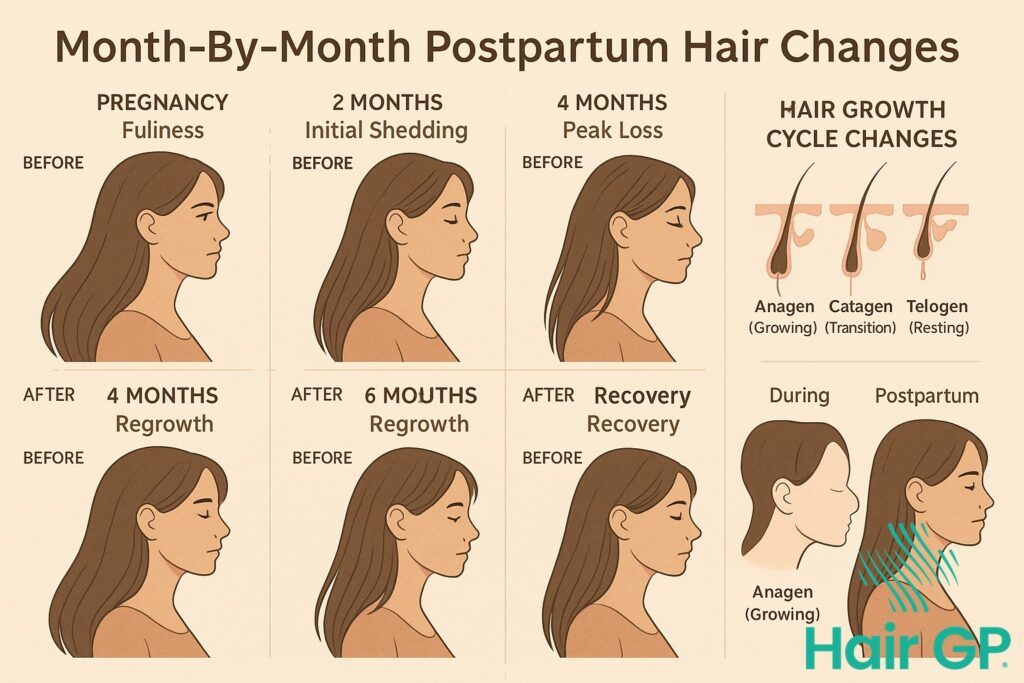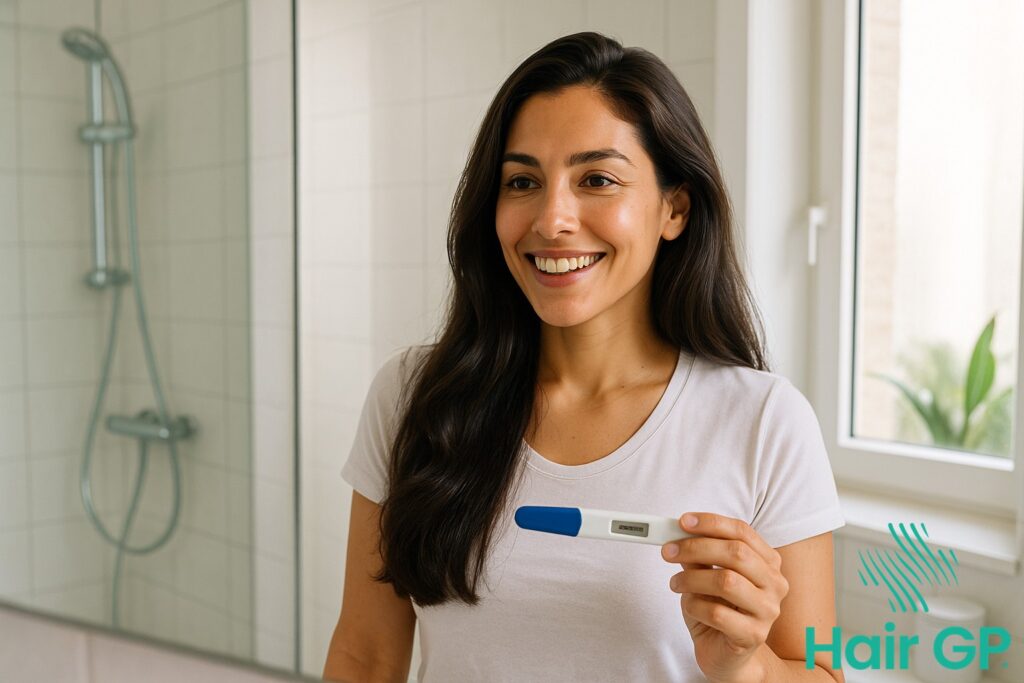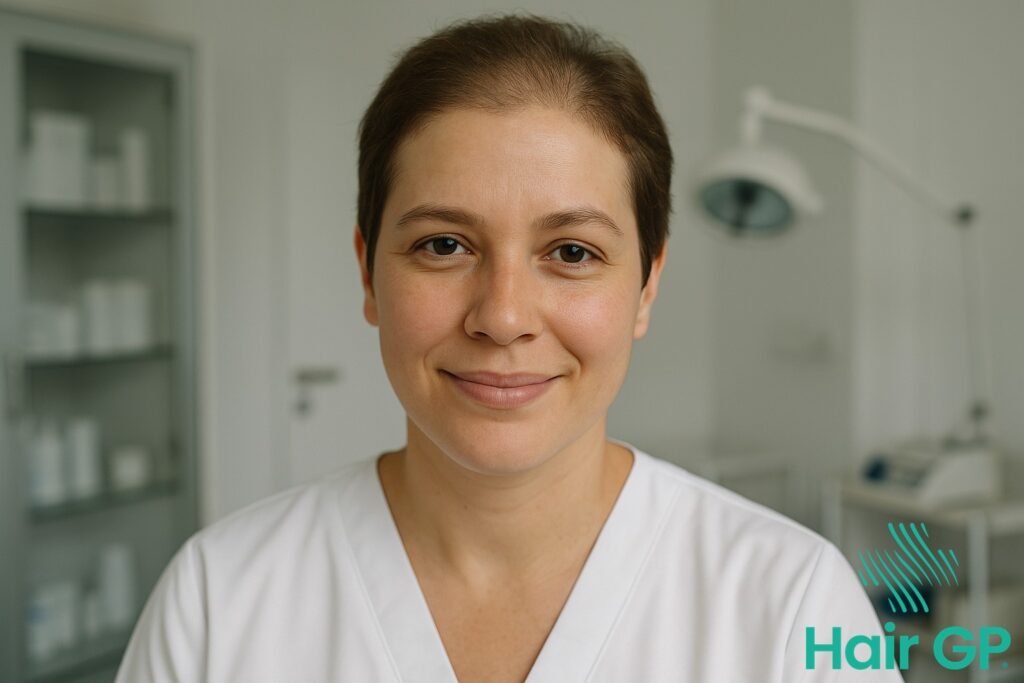Introduction
If you’ve noticed significant changes to your hair after giving birth, you’re not alone. Postpartum hair loss affects up to 90% of new mothers, making it one of the most common physical changes during postpartum recovery. Understanding your postpartum month-by-month hair timeline can help you navigate this temporary but often distressing experience with confidence and realistic expectations.
During pregnancy, elevated pregnancy hormones create a unique environment that dramatically affects your hair growth cycle. These hormonal changes typically result in thicker, more lustrous hair that many women enjoy throughout their pregnancy. However, the same hormones that give you that coveted “pregnancy hair” also set the stage for the hair changes you’ll experience after delivery.
This comprehensive guide will walk you through exactly what to expect during each phase of your postpartum hair journey. We’ll start by explaining the science behind your hair growth cycle and how pregnancy disrupts its natural rhythm. You’ll learn about the initial months when your hair may still appear full, followed by the peak shedding period that typically occurs between months four and six. We’ll then explore the encouraging signs of regrowth that begin to emerge in the latter half of your first year, and discuss the gradual recovery process that continues well beyond twelve months.
Throughout this timeline, we’ll address the various factors that can influence your individual experience, from breastfeeding and nutrition to stress levels and genetics. Most importantly, you’ll discover that whilst postpartum hair loss can feel overwhelming, it’s a temporary phase that resolves for the vast majority of women as their bodies adjust to their new normal.
Key Takeaways – TL/DR
- Postpartum hair loss typically peaks between 3-6 months after giving birth
- The hair growth cycle normalizes around 12-18 months postpartum
- Hormonal changes, not nutritional deficiency, cause most postpartum hair loss
- Most women see significant hair regrowth by their baby’s first birthday
Understanding Your Postpartum Hair Growth Cycle
Understanding the science behind postpartum hair loss begins with recognising how your natural hair growth cycle interacts with pregnancy hormones. This temporary condition, whilst distressing, follows predictable patterns that can be explained through the normal phases of hair follicle activity and hormonal fluctuations during and after pregnancy.
The Three Phases of Hair Growth
Your hair growth cycle consists of three distinct phases that determine when hair grows, transitions, and sheds [1]. The anagen phase is the active growth period, lasting 2-7 years, where hair follicles produce new hair continuously. During this phase, your hair grows approximately half an inch per month. The catagen phase follows as a brief transitional period lasting 2-3 weeks, where hair follicles shrink and detach from the blood supply. Finally, the telogen resting phase spans 2-4 months, during which hair remains dormant before naturally shedding to make way for new growth.
How Pregnancy Changes Your Hair Cycle
Pregnancy hormones, particularly elevated oestrogen levels, significantly disrupt your normal hair growth cycle by extending the anagen phase and reducing the number of follicles entering telogen [2]. This hormonal shift means more hair remains in the growth phase longer, creating the fuller, thicker hair many women experience during pregnancy. However, after delivery, hormone levels rapidly decline, causing a large number of hair follicles to simultaneously enter the telogen phase. This synchronised shedding, known as telogen effluvium, typically affects 40-50% of new mothers and peaks 3-4 months postpartum. The condition represents your hair follicles ‘catching up’ on the natural shedding that was delayed during pregnancy, explaining why postpartum hair loss can seem so dramatic despite being a completely normal biological process.

Months 1-3 Postpartum: The Calm Before the Storm
During the first three months postpartum, many new moms are pleasantly surprised to discover they still enjoy the fuller hair benefits from pregnancy. This initial postpartum period represents the calm before more noticeable changes occur, as your body hasn’t yet fully adjusted to post-pregnancy hormone levels. Understanding this phase of your fourth trimester helps establish realistic expectations for the months ahead.
What to Expect in Month 1
In the immediate weeks following delivery, your hair will likely maintain much of its pregnancy thickness and volume. The elevated oestrogen levels that contributed to your fuller hair during pregnancy don’t drop instantly, allowing you to enjoy these benefits a bit longer. During this first month, your primary focus should be on overall postpartum recovery rather than anticipating hair changes.
This is an ideal time to establish gentle hair care routines that will serve you well throughout your postpartum period. Opt for mild, sulphate-free shampoos and avoid harsh chemical treatments or excessive heat styling. Your scalp may be more sensitive during postpartum recovery, making gentle care essential. Consider loose hairstyles that don’t pull on your hairline, as this area may become more vulnerable in coming months.
Months 2-3: Subtle Changes Begin
As you progress through months postpartum two and three, you may begin noticing subtle shifts in your hair’s behaviour. Many women report slight texture changes during this period – hair might feel less silky or appear to have reduced shine compared to pregnancy levels. These early signs indicate your hormones are beginning their gradual transition back to pre-pregnancy states.
While dramatic changes haven’t yet occurred, this period offers an excellent opportunity to prepare for upcoming adjustments. Consider investing in quality hair products specifically designed for changing hair needs, and perhaps consult with a hairdresser familiar with postpartum hair changes. Building supportive habits now – including proper nutrition, adequate hydration, and stress management – creates a foundation for healthier hair throughout your entire postpartum journey.
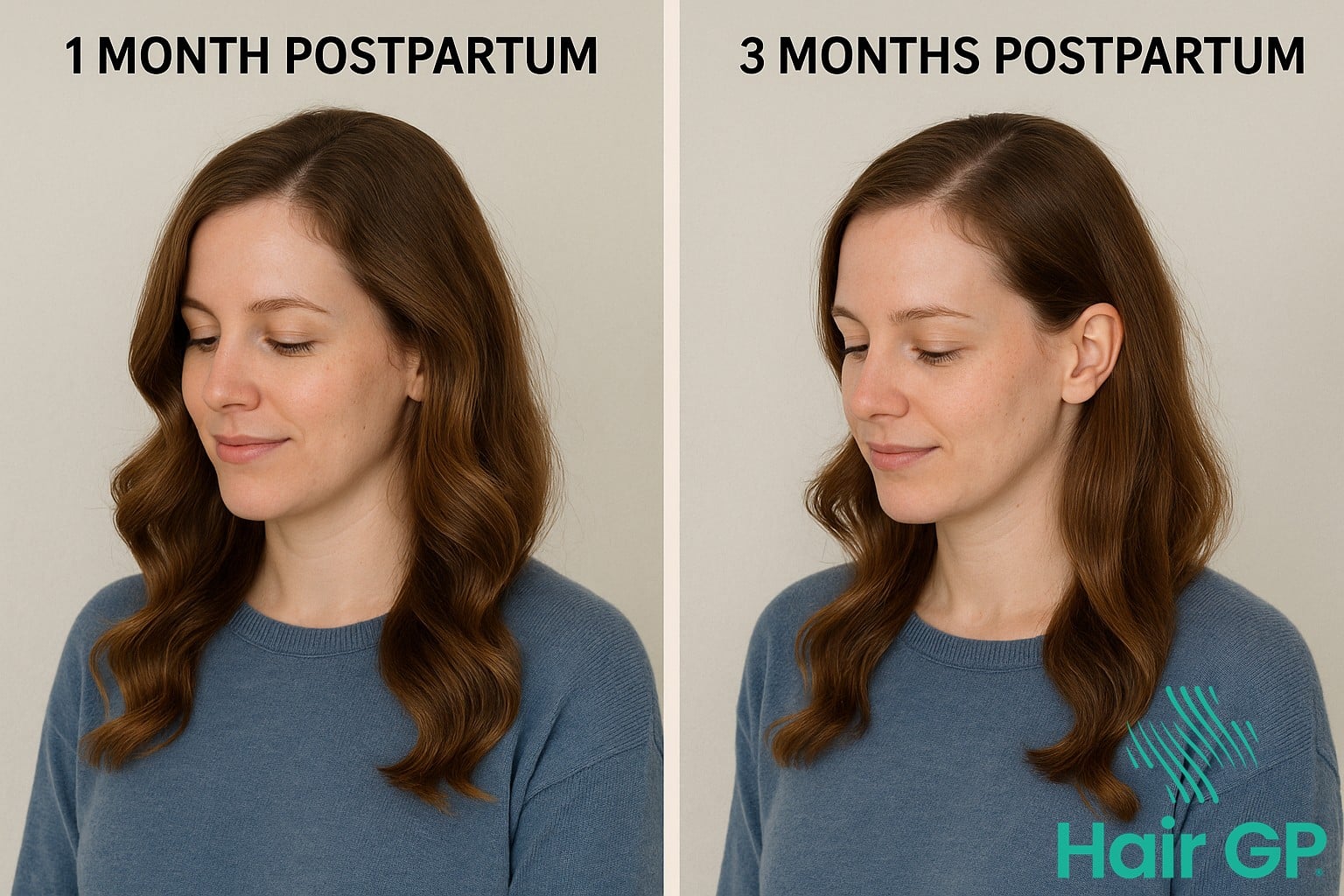
Months 4-6 Postpartum: Peak Hair Loss Period
The period between four to six months postpartum represents the most challenging phase for women who experience postpartum hair loss. During these months, hair shedding reaches its peak intensity, with many mothers noticing dramatically more hair falling out than usual. Understanding why this occurs and having effective management strategies can help navigate this temporary but distressing shedding phase.
Why Hair Loss Peaks Now
The timing of peak hair loss during months 4-6 postpartum is directly linked to hormonal fluctuations and the natural hair growth cycle. During pregnancy, elevated oestrogen levels kept hair in the anagen (growth) phase longer than normal, preventing typical daily shedding [3]. After delivery, hormone levels drop rapidly, triggering a delayed telogen phase where all the hair that should have been shed during pregnancy begins falling out simultaneously.
This hormonal shift means that instead of losing the typical 50-100 hairs daily, new mothers may experience hair thinning as they shed 200-400 hairs per day during peak periods [3]. The hair follicles are essentially catching up on months of delayed shedding, which explains why the hair falling seems so dramatic. This process reflects the natural cycle resumption as the body readjusts to non-pregnant hormone levels.
Managing Heavy Shedding
Coping with significant hair shedding requires both practical and emotional strategies. Gentle styling becomes crucial during this period – avoid tight ponytails, braids, or any hairstyles that create tension on the scalp. Consider protective hairstyles that minimise manipulation, such as loose buns or soft headbands that don’t pull at the hairline.
Emotionally, it’s essential to remember that this shedding phase is temporary. Many women find it helpful to take progress photos, however daily observation can make the hair loss seem more severe than it actually is. Connecting with other mothers who’ve experienced similar challenges can provide valuable emotional support during this difficult period.
Hair Care During Peak Loss
Maintaining proper hair care practices becomes particularly important when experiencing more hair loss. Use gentle, sulphate-free shampoos and wash hair only 2-3 times weekly to minimise unnecessary manipulation. When washing, massage the scalp gently with fingertips rather than scrubbing vigorously.
Avoid heat styling tools completely during peak shedding, as they can further weaken already fragile hair. Air-dry when possible and use wide-tooth combs on wet hair to prevent breakage. Nutritional support through a balanced diet rich in protein, iron, and vitamins can help support new hair growth as the cycle normalises.
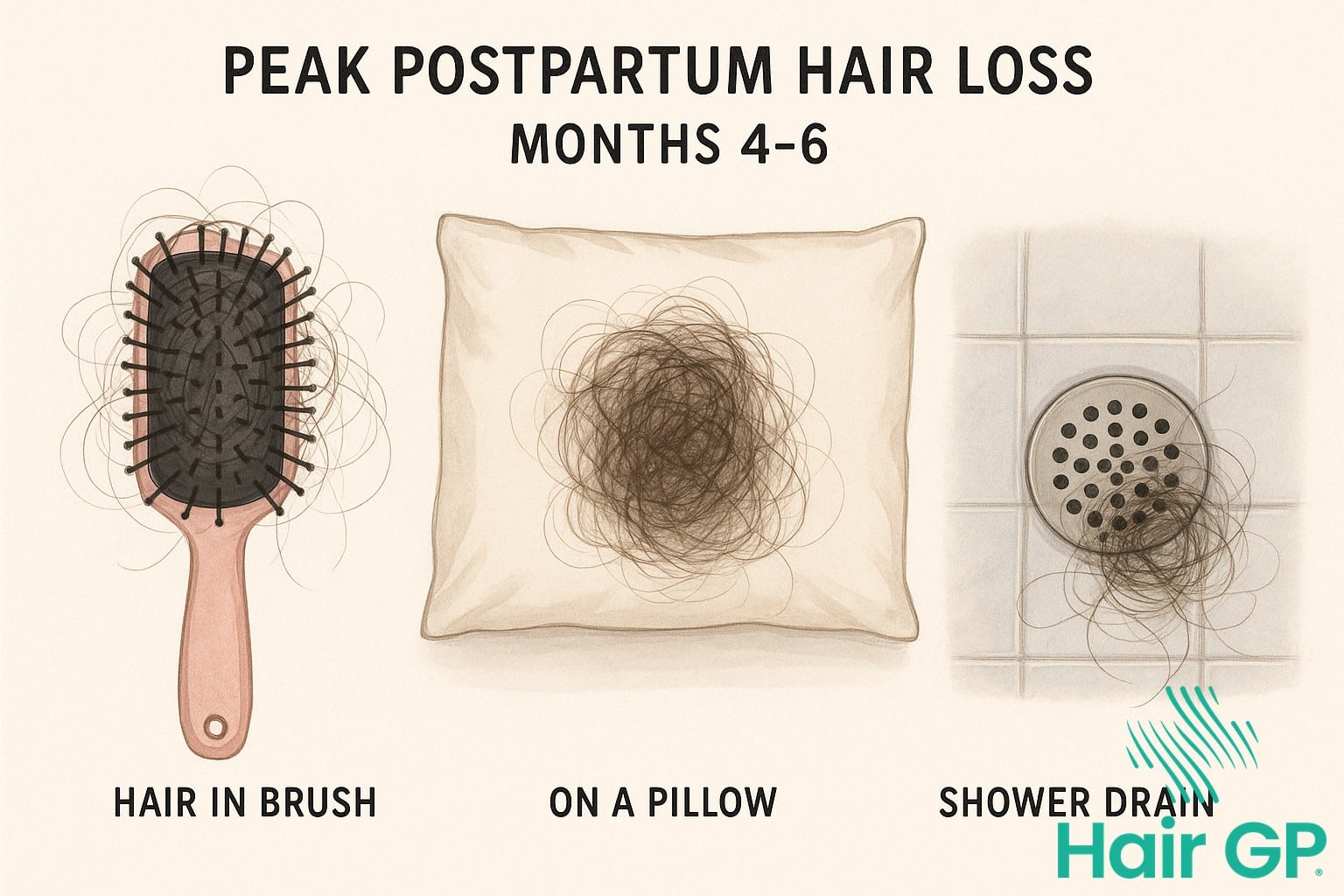
Months 7-9 Postpartum: Signs of Regrowth Begin
Between months seven and nine postpartum, many women experience a welcomed turning point in their hair journey as the intense shedding phase begins to subside. This transitional period marks when hair regrowth becomes more apparent, offering hope and tangible evidence that your hair recovers from the dramatic changes of pregnancy and early motherhood. Recognising these early signs of recovery helps maintain confidence during your ongoing postpartum journey.
Recognizing New Growth
The first signs of postpartum regrowth often appear as delicate baby hairs along your hairline and crown areas. These fine, wispy strands may initially seem almost fuzzy or flyaway, creating a soft halo effect around your face. Pay attention to your hairline, particularly around your temples and forehead, where new hair growth typically becomes visible first. You might notice these baby hairs standing upright or appearing shorter than your existing hair length.
Texture differences provide another key indicator of hair regrowth. New hair growth often feels softer and may appear lighter in colour initially, gradually darkening as it matures. Some women observe that their regrowth has a slightly different texture than their pre-pregnancy hair, which is completely normal. Take progress photos monthly to document subtle changes that might not be immediately apparent in daily observations. The overall density around your hairline should gradually improve, though this process requires patience as hair typically grows only half an inch per month.
Supporting Healthy Regrowth
Gentle scalp massage can significantly encourage healthy new hair growth by stimulating blood circulation to hair follicles. Spend five minutes daily massaging your scalp with your fingertips using circular motions, particularly focusing on areas where you’re hoping to see regrowth. This simple practice also helps reduce stress, which directly benefits hair health.
Maintaining proper nutrition remains crucial during this regrowth phase. Continue taking prenatal vitamins or a quality multivitamin containing biotin, iron, and vitamin D. Include protein-rich foods, leafy greens, and healthy fats in your diet to provide essential building blocks for strong hair growth. Managing stress through adequate sleep, gentle exercise, and relaxation techniques creates optimal conditions for your hair to thrive during this recovery period.
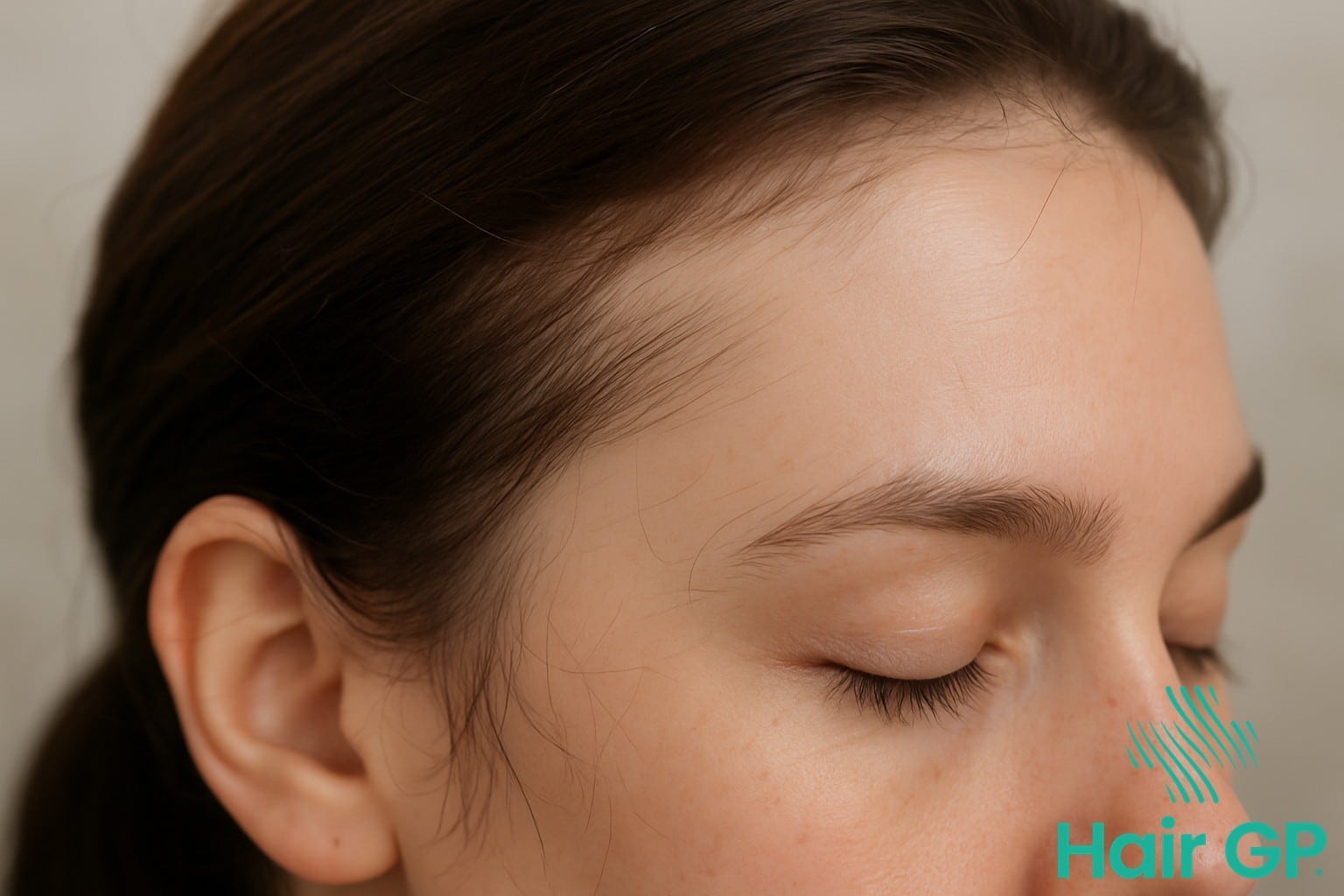
Months 10-12 Postpartum: Recovery Phase
By months 10-12 postpartum, many women enter the recovery phase where hair density improvements become more noticeable and growth patterns begin normalising. This period marks a significant turning point in postpartum hair recovery, with most mothers experiencing reduced shedding and the emergence of new growth. Understanding what to expect during this crucial phase helps mothers monitor their progress and identify when professional guidance may be beneficial.
Progress Markers at One Year
Several key indicators signal successful hair recovery by the 12-month mark. Hair thickness typically shows marked improvement, with many women noticing more hair volume and density compared to the early postpartum months. The excessive shedding experienced during the telogen effluvium phase should have significantly reduced, returning closer to normal daily hair loss of 50-100 strands. New growth becomes increasingly visible, particularly around the hairline and crown areas where loss was most pronounced. The quality of hair health often improves during this period, with strands appearing stronger and less brittle. Many mothers report that their hair feels more manageable and resilient, though texture changes from pregnancy may persist. Healthy hair growth patterns gradually establish themselves, with the hair growth cycle returning to its pre-pregnancy rhythm of anagen, catagen, and telogen phases.
Discussing Progress with Healthcare Provider
The 12-month postpartum checkup provides an ideal opportunity to discuss hair concerns with healthcare providers. Normal recovery patterns include gradually increasing hair thickness and reduced shedding, whilst concerning signs may include continued excessive hair loss, patchy bald spots, or complete absence of new growth. Women should seek professional help if hair recovery appears stalled or if underlying conditions like thyroid disorders or nutritional deficiencies are suspected. Healthcare providers can assess whether additional treatment options are necessary, such as topical treatments, nutritional supplements, or referrals to dermatologists. During the postpartum checkup, mothers should discuss their hair recovery timeline and any concerns about their hair health progress. Early intervention can be beneficial when recovery patterns deviate significantly from normal expectations, ensuring optimal outcomes for long-term hair recovery.
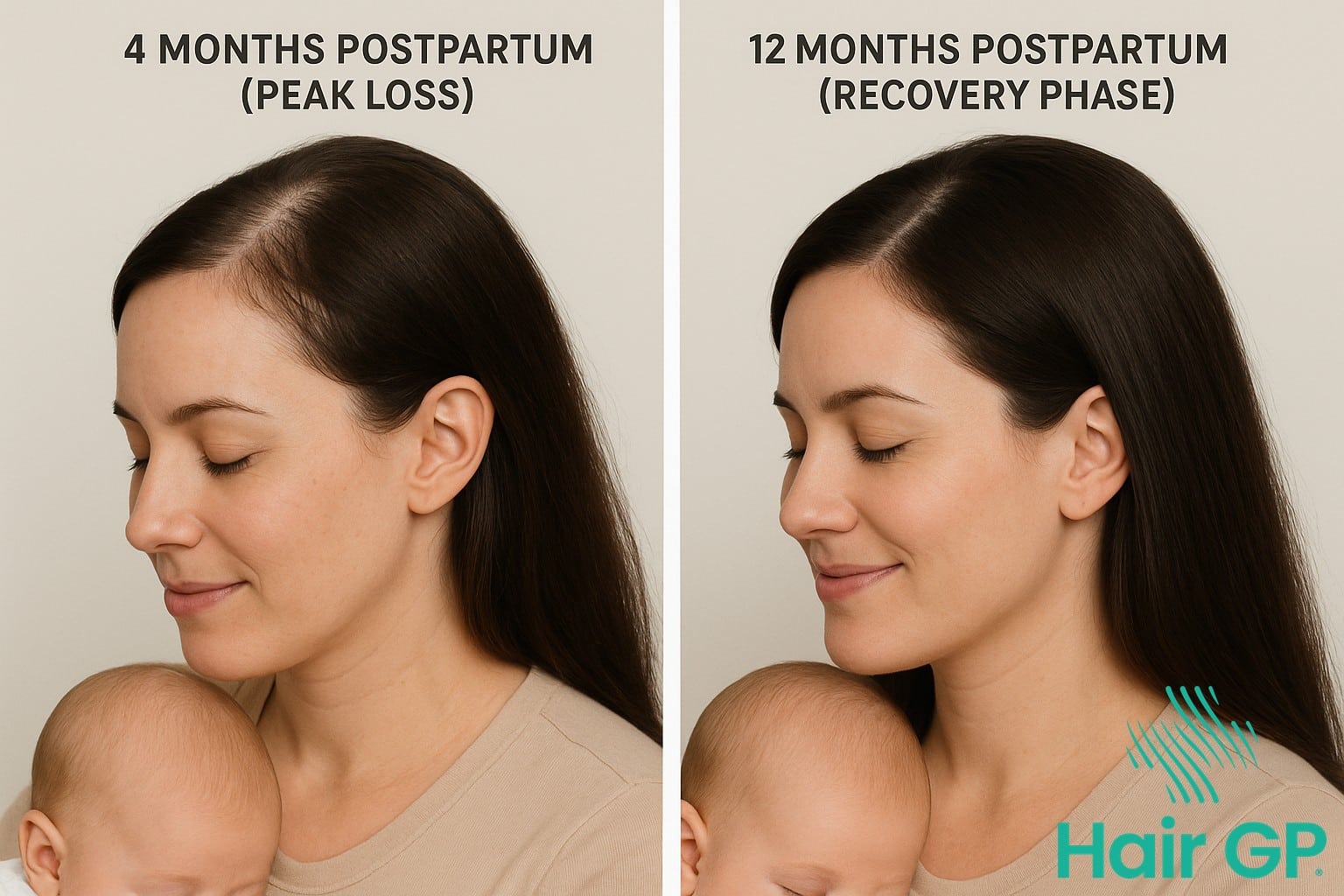
Beyond Year One: Long-term Hair Recovery
Complete hair recovery following pregnancy follows a predictable postpartum timeline, though the journey extends well beyond the initial twelve months. Whilst many women expect rapid restoration, achieving pre pregnancy hair density and quality typically requires patience, as full recovery often spans 12-18 months postpartum [4].
Months 13-18: Final Recovery Phase
During this crucial period, hair growth patterns undergo complete normalisation, marking the final phase of postpartum recovery. New hair growth becomes increasingly robust, with strands achieving their pre-pregnancy thickness and strength. Full density restoration occurs gradually, as the hair follicles that entered prolonged resting phases during early months postpartum resume their normal cycling patterns.
By 18 months postpartum, most women experience completely normalised shedding patterns, losing approximately 50-100 hairs daily rather than the excessive amounts experienced during peak postpartum hair loss. This represents a return to healthy hair growth cycles, where the anagen (growth) phase extends to its typical 2-6 year duration. When comparing current hair density to pre pregnancy photographs, most women find their hair has returned to approximately 90-95% of its original fullness.
When Hair Doesn’t Fully Recover
However, some women find their hair loss continues beyond typical recovery timeframes, particularly when multiple factors intersect. Age plays a significant role, as women over 35 may experience slower recovery due to naturally declining hormone levels [5]. Multiple pregnancies can compound recovery challenges, as repeated hormonal fluctuations may affect follicle resilience. Additionally, underlying conditions such as thyroid disorders, nutritional deficiencies, or genetic predisposition to androgenetic alopecia can impede complete restoration, requiring targeted intervention for optimal outcomes.
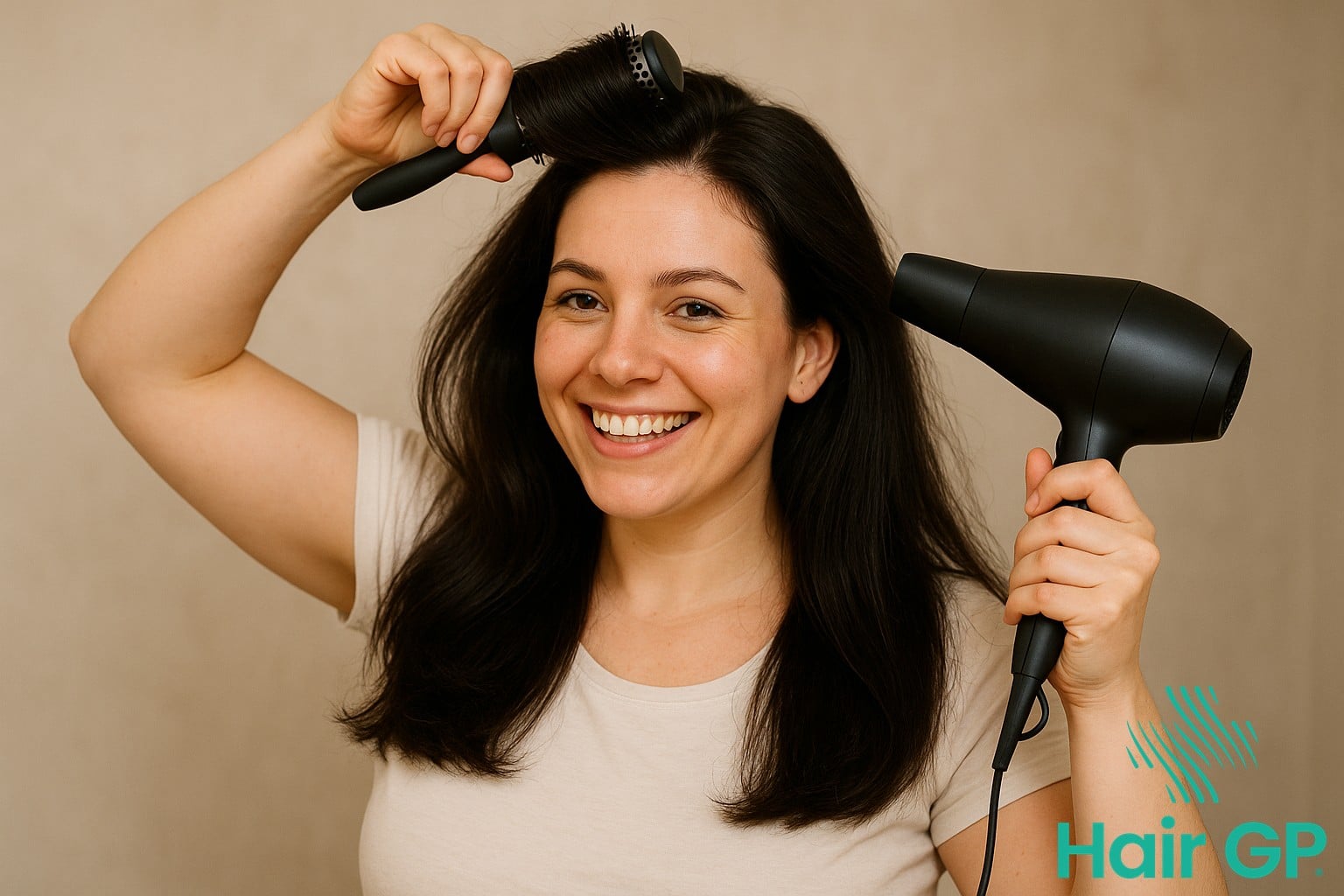
Factors That Affect Your Hair Timeline
Postpartum hair recovery timelines vary significantly amongst women, with individual factors playing crucial roles in determining both the severity and duration of hair changes. Understanding these variables helps set realistic expectations and prevents unnecessary concern about personal recovery patterns.
Breastfeeding and Hair Recovery
Breastfeeding can extend postpartum hair loss beyond the typical six-month window due to continued hormonal fluctuations [6]. The prolactin hormone produced during breastfeeding maintains lower oestrogen levels, which can prolong the telogen phase and delay normal hair cycling. Women who breastfeed may experience hair loss continuing for 12-15 months postpartum, representing normal variation rather than cause for concern. This extended timeline doesn’t indicate an inability to prevent postpartum hair loss but reflects natural hormonal processes.
Other Influencing Factors
Several lifestyle and health factors significantly impact hair recovery speed and success. Chronic stress and poor stress management can exacerbate hair loss by elevating cortisol levels, which disrupt normal hair growth cycles. Mental health challenges, including postpartum depression, may compound hair loss through both physiological stress responses and reduced self-care behaviours. Nutrition plays a vital role, with deficiencies in iron, protein, and essential vitamins directly affecting hair follicle function and growth rates. Sleep quality substantially influences recovery, as inadequate rest impairs cellular repair processes essential for healthy hair growth. Women experiencing multiple stressors simultaneously may see prolonged recovery periods, whilst those maintaining good nutrition, adequate sleep, and effective stress management typically recover more quickly.
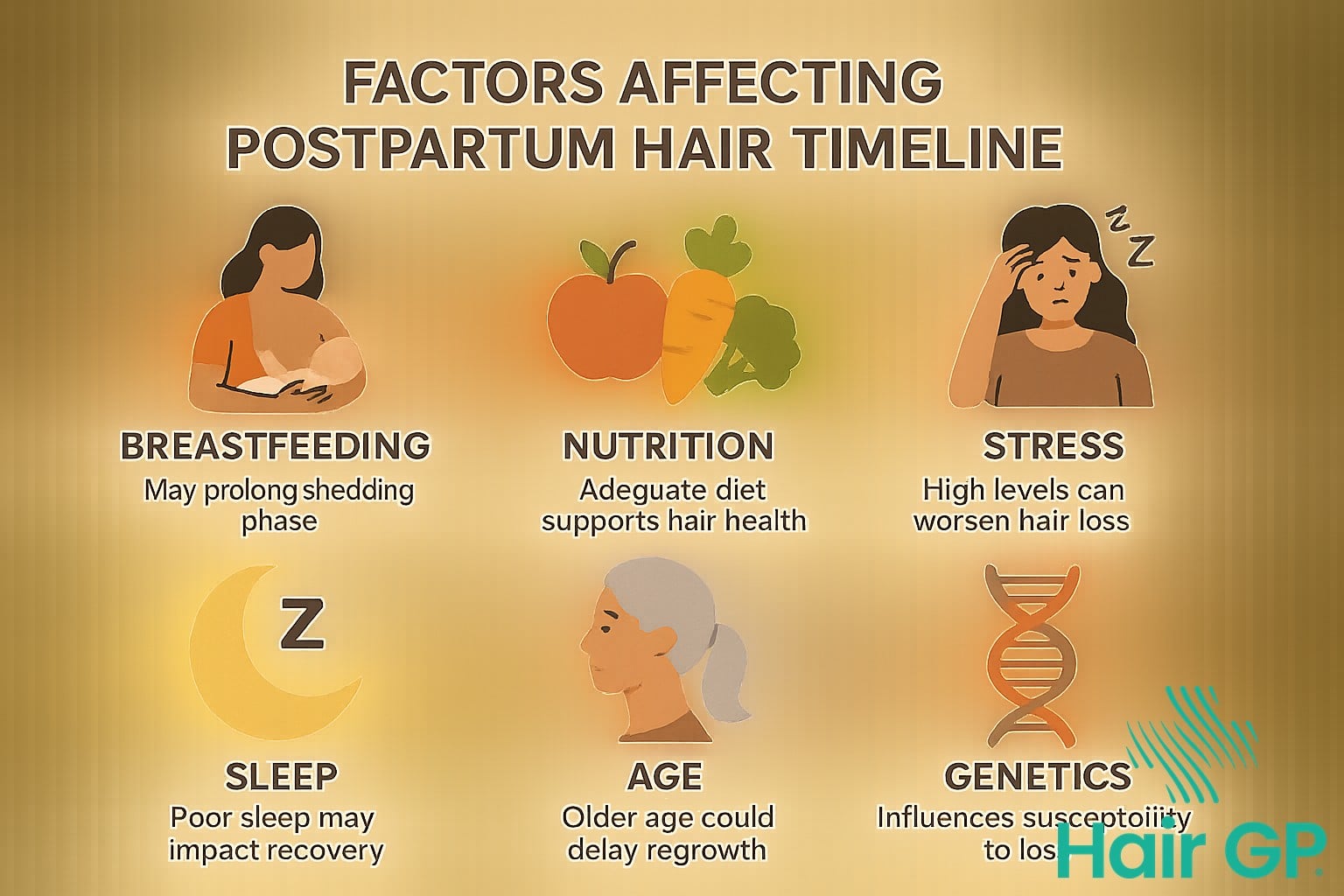
Conclusion
Understanding your postpartum month-by-month hair timeline can provide tremendous reassurance during what might feel like an overwhelming period of change. For new mothers experiencing hair loss after childbirth, it’s essential to remember that this process is completely normal and temporary. The vast majority of women see their hair growth patterns return to normal within 12 to 18 months following delivery.
Your postpartum recovery journey is unique, and hair regrowth is just one aspect of your body’s remarkable ability to heal and restore itself. While the initial shedding phase can be distressing, particularly when it peaks around three to four months postpartum, your hair follicles are simply resetting themselves after the hormonal changes of pregnancy and birth.
If you’re concerned about the extent of your hair loss or notice it continuing beyond the typical timeline, don’t hesitate to consult your healthcare provider. They can assess whether additional factors might be contributing to your hair loss and provide personalised guidance for your specific situation and circumstances.
Remember that patience is absolutely key during this natural recovery process. Focus on maintaining good nutrition, managing stress levels, and being gentle with your hair care routine. Your crowning glory will return, and you’ll emerge from this challenging phase of new motherhood with renewed confidence and beautiful, healthy hair once again.
Frequently Asked Questions
Yes, postpartum hair loss occurs regardless of delivery method. Both vaginal delivery and cesarean birth trigger the same hormonal changes that cause hair shedding, as the hair loss is related to pregnancy hormone changes, not the birth process itself.
Postpartum hair loss cannot be completely prevented as it’s a natural result of hormonal changes. However, maintaining good nutrition, managing stress, and gentle hair care can help minimize the severity and support healthy regrowth.
Contact your healthcare provider if hair loss continues beyond 12 months, if you notice bald patches, or if hair loss is accompanied by other symptoms like fatigue or mood changes, as these may indicate underlying conditions.
Most women see significant hair recovery by 12-18 months postpartum, though some may notice permanent changes in texture or density. Multiple pregnancies and age can affect the extent of recovery.
References
- Hoover E, Alhajj M, Flores JL. Physiology, Hair. In: StatPearls. Treasure Island (FL): StatPearls Publishing; 2022.
- Grymowicz M, Rudnicka E, Podfigurna A, et al. Hormonal Effects on Hair Follicles. Int J Mol Sci. 2020;21(15):5342.
- Grover C, Khurana A. Postpartum alopecia: An under-recognized cause of hair loss in women. Int J Trichology. 2020;12(4):157-164.
- Grymowicz M, Rudnicka E, Podfigurna A, et al. Hormonal effects on hair follicles. Int J Mol Sci. 2020;21(15):5342.
- Hadshiew IM, Foitzik K, Arck PC, Paus R. Burden of hair loss: stress and the underestimated psychosocial impact of telogen effluvium and androgenetic alopecia. J Invest Dermatol. 2004;123(3):455-457.
- Grymowicz M, Rudnicka E, Podfigurna A, et al. Hormonal Effects on Hair Follicles. Int J Mol Sci. 2020;21(15):5342.

